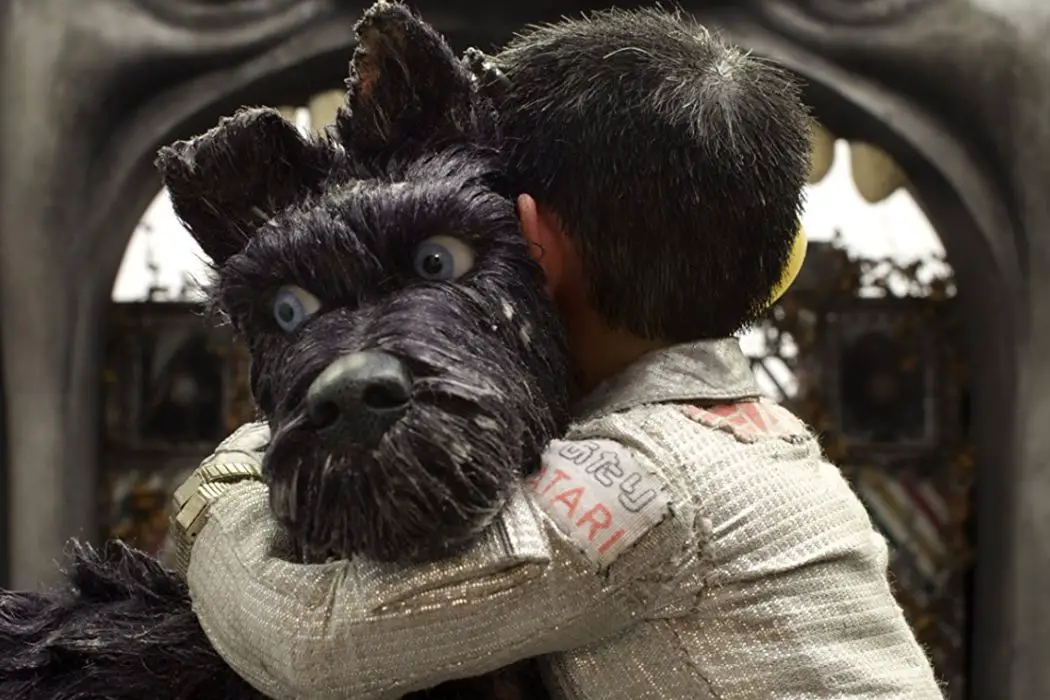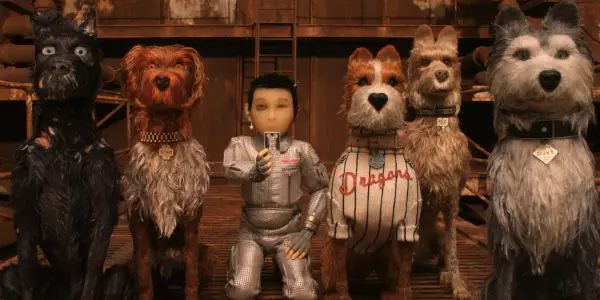ISLE OF DOGS: A Gorgeous Canine Parable That’s Ruff Around The Edges

Gus is a 3rd year English Lit and Creative Writing…
The world of Wes Anderson is instantly recognisable. It’s symmetrical, melancholic, separated into chapters, and, if Moonrise Kingdom, The Life Aquatic and Royal Tenenbaums are to be believed, one populated with dog cruelty. Isle of Dogs, then, a canine parable that centers its gaze almost entirely on man’s best friend, may bear the signs of his grimmest yet.
This is not the case: for all the disease, danger and overt Trump-related reverberations, Wes Anderson’s ninth feature film (and second stop-motion animation, following Fantastic Mr. Fox) is decidedly feel-good. The setting is Japan, twenty years into the future, where a flu has ravaged its population of dogs. To rectify the situation, the tyrannical Mayor Kobayashi (Kunichi Nomura) goes ahead with an executive order to quarantine the dogs and dump them on the city’s Trash Island.
In doing so, he gets rid of Spots (Liev Schreiber), a bodyguard dog (fit with an ear device and military-grade explosive teeth) who just so happens to be in charge of looking after the mayor’s own ward, a proactive young boy named Atari (Koyu Rankin). Enraged, Atari decides to venture off on his own to the waste-land in search of the dog. He crash-lands a miniature airplane, and wakes up to a gaggle of diseased canines, all domesticated save for the ragged and stubborn Chief (Bryan Cranston). What follows for much of the second act is a time-jumping road movie where the pack and their young pilot roam Trash Island in search of the lost dog.
Even The Garbage Looks Great
This island, a forgotten pile of sludge and fumes, is achingly beautiful. Picture the stunning waterfall backdrop of Fantastic Mr. Fox, and spread that out across Isle of Dogs’ entire runtime – heaps of garbage have never looked so tantalising. The film contains a Miyazaki-esque penchant for gorgeously realised landscape shots, exaggerated with silent reflection: greying grass billows in the wind, oil-stained rivers flow downstream. Its world may be fabricated and entirely man-made, but Anderson still gives it a natural beauty.

Kurosawa, too, is referenced in the film’s insistence on deep focus, a visual flourish hardly seen in Anderson’s filmography, but a welcome one considering the film’s hodgepodge of Japanese sensibilities. Isle of Dogs’ one aesthetic misstep is in its camera exposure, where a sickly motion blur effect may do your head in – until you eventually become desensitised to it. Whether a problem with the projection (promotional clips seem to do without it) or an intentional effect by Anderson, it’s disastrously distracting.
Its first act is blisteringly paced, with enough visual invention to make Guy Maddin blush. Flitting between stop-motion and Japanese woodblock print (including a blatant homage to Hokusai’s The Great Wave), the film gets its setting and exposition out of the way before you can finally get rid of that goofy grin (not only is it quick, it’s quick-witted, fit with visual gags aplenty and only resorting to doggy-based puns during the canines’ introductory scene). By the time we get to the island, we’ve already gorged ourselves on rich world-building and sumptuous visuals.
Shaggy-Dog Politics And Pacing
The story itself, on the other hand, is a little more uneven. The Trump-based reverberations are as overt as they come, but also largely ineffective: all bark and no bite. Its subject of attack is the corrupt mayor, a cat-loving man of power (this film won’t do anything to quell the cat vs dog debate) who uses a team of propagandists and acts of violence and murder to stamp down opposition. Anderson stated that when working on this film he decided on a political climate for his fantasy world that felt ‘right for the moment’, but his take on a Trump-like situation is diluted somewhat by what goes on over at Trash Island.
For Isle of Dogs reuses Fantastic Mr. Fox’s ‘wild vs domestic’ angle and applies it to Bryan Cranston’s Chief, a stray who’s initially much more content with independence over ownership. His arc parallels Mayor Kobayashi’s plot strand and theme of dictatorship in a manner less harmonious and more contradictory; Chief urged to follow the boy pilot’s exact orders.
I’m not exactly sure what Anderson is trying to say here – that dictatorship is acceptable if treated well, perhaps – but the message is muddled by Atari’s attempts to domesticate Chief being less charming and more insistent. In this relationship, it’s the human barking orders at the dog. Of course, the argument that dogs should follow the commands of human’s is hardly baseless, but when it is offset by the plot strand of a corrupt mayor with a firm grip on his city, it becomes self-critical, as if Anderson is urging his film’s message to implode on itself.
The beauty of Isle of Dogs may be a double-edged sword. The film is rendered in a painstaking detail, that, accompanied by the notorious effort needed for stop-motion animation, has inevitably taken a long time to craft. Which explains away a few of the film’s pacing issues: the ending is wrapped up a little too neatly for my liking (and for the off-color tone the film sets), and character decisions are made in such haste that the potential for substantial emotional heft is left behind. Chalk it down to me not being a dog person, but for all of Isle of Dogs’ stabs at moments of maudlin (its characters well up in more instances than any other Anderson flick by quite some margin), I found it a largely unaffecting film.
Perhaps more time should have been spent on building up to these melancholic sequences, rather than spent dawdling with half-hearted all-dog interactions that seem more like padding than anything important to the narrative. Nutmeg (Scarlett Johansson), for instance, is entirely wasted, a character whose only role is to briefly put Chief’s morals in perspective. Greta Gerwig’s exchange-student activist, who spearheads the opposition of Mayor Kobayashi, at least has more agency and definition, but her sabotage subplot is infinitely less interesting than anything over at Trash Island. It’s a shame that, in a film dominated by males, its two most prominent female characters are underutilised.
Paw-sistent Imagination
Though don’t be alarmed: if emotionally distant and awkwardly paced, the film provides enough joyous moments of inspiration to prove Isle of Dogs as an impressive addition to Anderson’s catalogue of films. Acknowledging the inherent comedy of pugs (I mean, just look at them),the film lays it on thick by having its pug be seemingly psychic, named Oracle, and played by Tilda Swinton.
The film playfully flirts with translation, too, introducing a disparate collection of methods of transferring Japanese language to our non-Japanese ears (whether it be through newsreaders, witty subtitles or hand gestures, writers Anderson and Jason Schwartzman milk its potential for humour). And in the instances when no translation is offered, that too is playfully jabbed at: ‘Jeez, I wish somebody spoke his language’.

Its orientalism is treated with a sensitivity that, while expected from Anderson, is refreshing considering the whitewashed climate of Hollywood. Alexandre Desplat plays a huge part in this, his experimental score a clashing of Japanese-inspired drums, cymbals and bells that’s thrillingly infused into the narrative.
Conclusion: Isle of Dogs
It’s decidedly not a film for young kids – a sushi sequence borders the fine line between cutesy and grotesque, while a kidney operation does away with the cutesy altogether – but the use of stop-motion may put off older viewers. It’s difficult to know who this film is for – apart from cinephiles – which may lead to a financial haul as similarly modest as Fantastic Mr. Fox. I hope not though: Isle of Dogs may be ruff around the edges, but it’s an exquisitely rendered animation overloaded with visual gags and dry humour, and an exciting parable on man’s best friend that fits snugly into the world of Wes Anderson.
Are you excited for Isle of Dogs. What Wes Anderson film is your favourite? Let us know in the comments below!
Isle of Dogs will be released in the US on March 23rd 2018, and in the UK on March 30th. For all international release dates, see here.
Does content like this matter to you?
Become a Member and support film journalism. Unlock access to all of Film Inquiry`s great articles. Join a community of like-minded readers who are passionate about cinema - get access to our private members Network, give back to independent filmmakers, and more.
Gus is a 3rd year English Lit and Creative Writing student who loves everything film and still doesn't understand why he didn't study that instead. He is the co-editor for Venue, the arts supplement of his Uni's newspaper, and has written for Little White Lies, ScreenRant, Dog and Wolf, BritFlicks and Outline Norwich.













